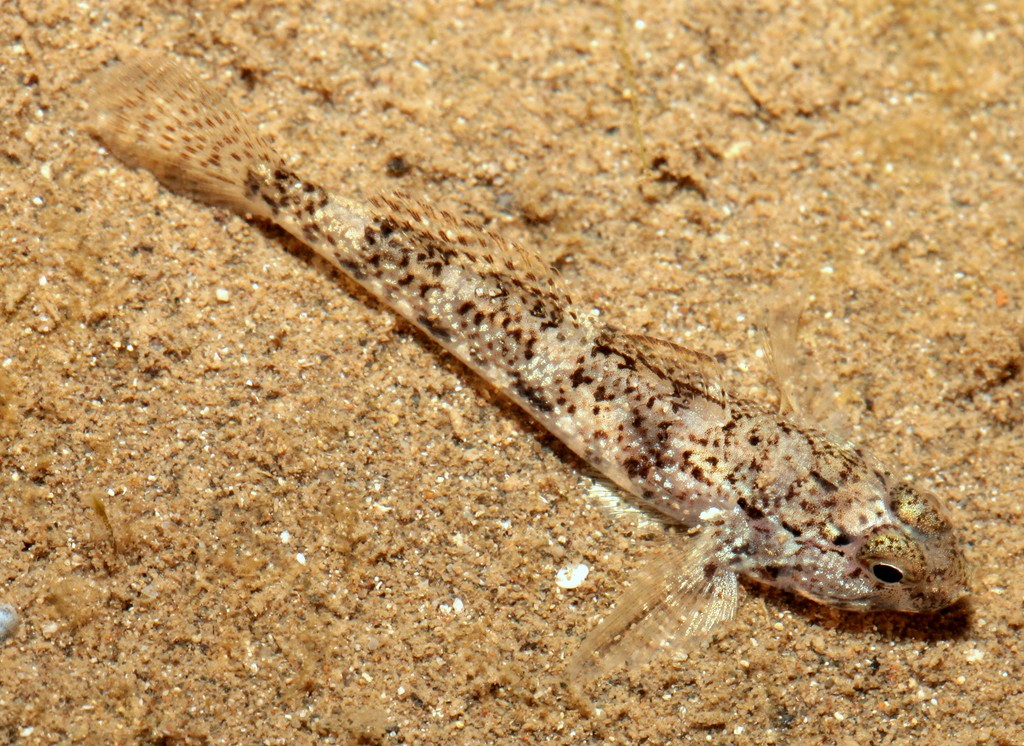FAVONIGOBIUS REICHEI - (BLEEKER, 1854)
Actinopterygii (Gigaclass) > Actinopteri (Class) > Teleostei (Subclass) > Gobiiformes (Order) > Gobioidei (Suborder) > Gobiidae (Family) > Gobiinae (Subfamily) > Favonigobius (Genus)
Indo-Pacific tropical sand goby, Tropical sand goby, Tropiese sand-dikkop, Minami-himehaze, ミナミヒメハゼ,
Synonymes
Aboma aliciae (Herre, 1936)
Acentrogobius ennorensis (Menon & Rema Devi, 1980)
Acentrogobius neilli (Day, 1868)
Acentrogobius reichei (Bleeker, 1854)
Ctenogobius cylindricus (Bleeker, 1875)
Favonigobius neilli (Day, 1868)
Gobius baliuroides (Bleeker, 1849)
Gobius littoreus (Day, 1888)
Gobius neilli (Day, 1868)
Gobius reichei (Bleeker, 1854)
Gobius zanzibarensis (Liénard, 1891)
Papillogobius reichei (Bleeker, 1854)
Papillonigobius reichei (Bleeker, 1854)
Pomatoschistus bacescui (Nalbant & Mayer, 1975)
Rhinogobius baliuroides (Bleeker, 1849)
Rhinogobius robinsoni (Fowler, 1934)
-----------------------------
Description
Dorsal spines (total): 7; Dorsal soft rays (total): 8; Anal spines: 1; Anal soft rays: 7-8. longitudinal scale series: 27; Depth of body: 6.1 in SL. Second dorsal spine forming elongate, threadlike filament; Pelvic fins united medially; Presence of pelvic frenum; Rounded caudal fin; Ctenoid scales except cycloid on breast and pectoral fin base; Predorsal scales: 3, scale absent on remainder of head. Max. length: 8.3 cm TL. Depth range: 0 - 5 m.
Indo-Pacific tropical sand goby, Tropical sand goby, Tropiese sand-dikkop, Minami-himehaze, ミナミヒメハゼ,
Synonymes
Aboma aliciae (Herre, 1936)
Acentrogobius ennorensis (Menon & Rema Devi, 1980)
Acentrogobius neilli (Day, 1868)
Acentrogobius reichei (Bleeker, 1854)
Ctenogobius cylindricus (Bleeker, 1875)
Favonigobius neilli (Day, 1868)
Gobius baliuroides (Bleeker, 1849)
Gobius littoreus (Day, 1888)
Gobius neilli (Day, 1868)
Gobius reichei (Bleeker, 1854)
Gobius zanzibarensis (Liénard, 1891)
Papillogobius reichei (Bleeker, 1854)
Papillonigobius reichei (Bleeker, 1854)
Pomatoschistus bacescui (Nalbant & Mayer, 1975)
Rhinogobius baliuroides (Bleeker, 1849)
Rhinogobius robinsoni (Fowler, 1934)
-----------------------------
Description
Dorsal spines (total): 7; Dorsal soft rays (total): 8; Anal spines: 1; Anal soft rays: 7-8. longitudinal scale series: 27; Depth of body: 6.1 in SL. Second dorsal spine forming elongate, threadlike filament; Pelvic fins united medially; Presence of pelvic frenum; Rounded caudal fin; Ctenoid scales except cycloid on breast and pectoral fin base; Predorsal scales: 3, scale absent on remainder of head. Max. length: 8.3 cm TL. Depth range: 0 - 5 m.
Color
Body with small spots; Sides with 4-5 groups of black spots, last spot on caudal peduncle often paired without a vertical bar at caudal base; Median fins spotted; Paired fins pale. Large males with dusky first dorsal, anal and pelvic fins.
Etymology
Favonigobius: from Latin, favonius = in the Roman mythology, he was the god of the west wind. He is also the husband of Flora and the father of Karpos. He is the Roman counterpart of Zephyrus + from Latin, gobius = gudgeon.
Reichei: in honor of M. Th. Reiche, Surgeon Colonel, a resident of Indonesian town of Padang.
Pieter Bleeker, in Ichthyologiae - Archipelagi Indici - Promodus, 1858 vol.1 - P. 17 writed : "The larger part of the honour of the numerous discoveries, mentioned in this work, therefore is due to those disinterested co-operators and therefore it is for me a dire obligation, to mention here with gratitude the names of all, who by their consignments have enabled me to advance science with a not unimportant step. Those names already form a long list and at present I see among them many who have succumbed to the blows of the tropical climate."
Original description: Gobius reichei Bleeker, 1854 - Type locality: Padang, Sumatra, Indonesia.
Distribution
Red Sea, Indo-West Pacific: East Africa, South Africa, Persian Gulf, Socotra, Seychelles, Madagascar and Mauritius (Mascarenes) east to Marshall Islands and New Guinea, north to southern Japan, south to northern Australia and New Caledonia.
Biology
Usually in small groups. Found over sandy and muddy bottoms, often in weedy areas of intertidal zone; Also in mangroves, estuaries, lagoons and rivers.
Similar species
Favonigobius exquisitus (Whitley, 1950) - Reported from Australia and New Zealand.
Etymology
Favonigobius: from Latin, favonius = in the Roman mythology, he was the god of the west wind. He is also the husband of Flora and the father of Karpos. He is the Roman counterpart of Zephyrus + from Latin, gobius = gudgeon.
Reichei: in honor of M. Th. Reiche, Surgeon Colonel, a resident of Indonesian town of Padang.
Pieter Bleeker, in Ichthyologiae - Archipelagi Indici - Promodus, 1858 vol.1 - P. 17 writed : "The larger part of the honour of the numerous discoveries, mentioned in this work, therefore is due to those disinterested co-operators and therefore it is for me a dire obligation, to mention here with gratitude the names of all, who by their consignments have enabled me to advance science with a not unimportant step. Those names already form a long list and at present I see among them many who have succumbed to the blows of the tropical climate."
Original description: Gobius reichei Bleeker, 1854 - Type locality: Padang, Sumatra, Indonesia.
Distribution
Red Sea, Indo-West Pacific: East Africa, South Africa, Persian Gulf, Socotra, Seychelles, Madagascar and Mauritius (Mascarenes) east to Marshall Islands and New Guinea, north to southern Japan, south to northern Australia and New Caledonia.
Biology
Usually in small groups. Found over sandy and muddy bottoms, often in weedy areas of intertidal zone; Also in mangroves, estuaries, lagoons and rivers.
Similar species
Favonigobius exquisitus (Whitley, 1950) - Reported from Australia and New Zealand.
